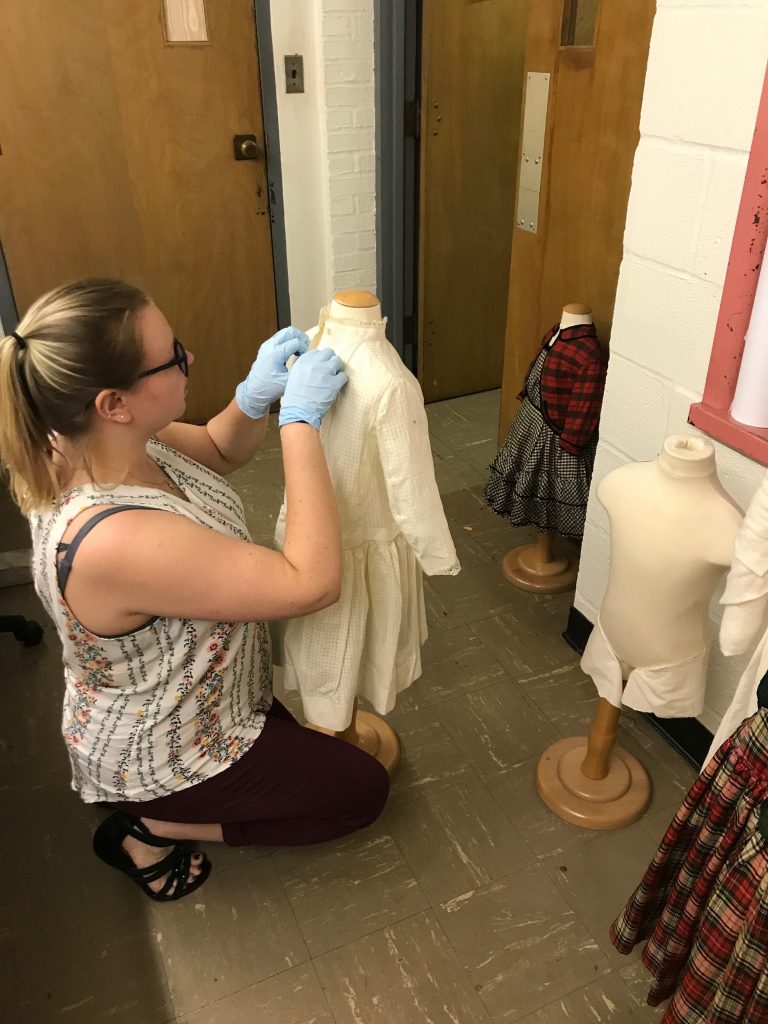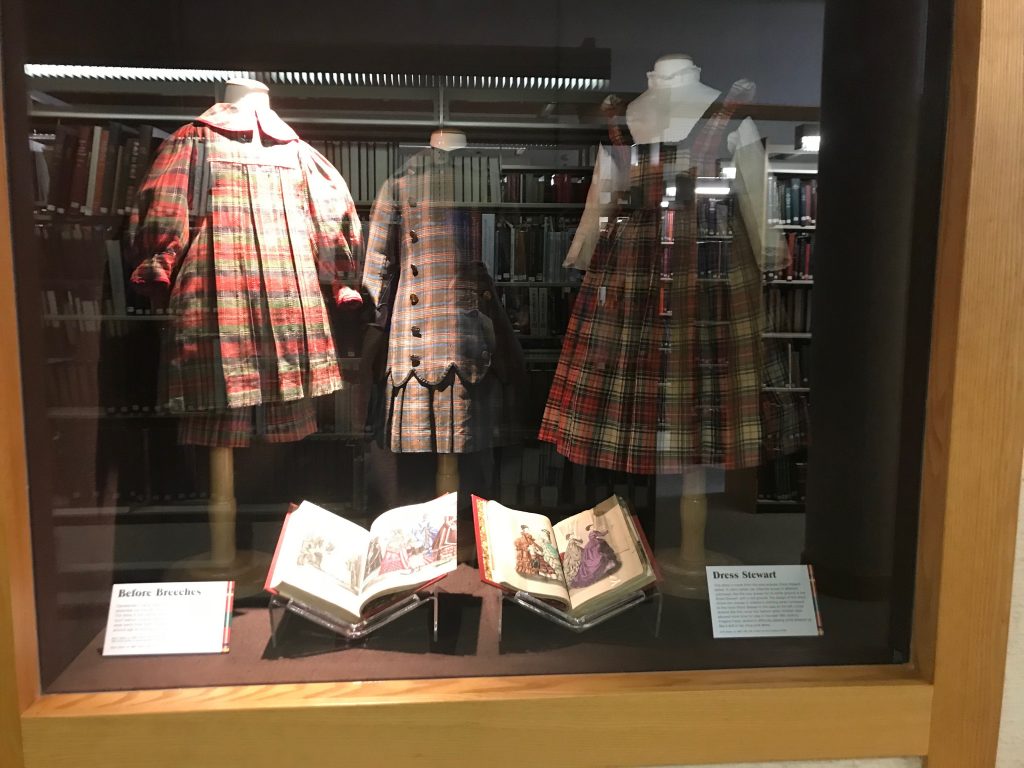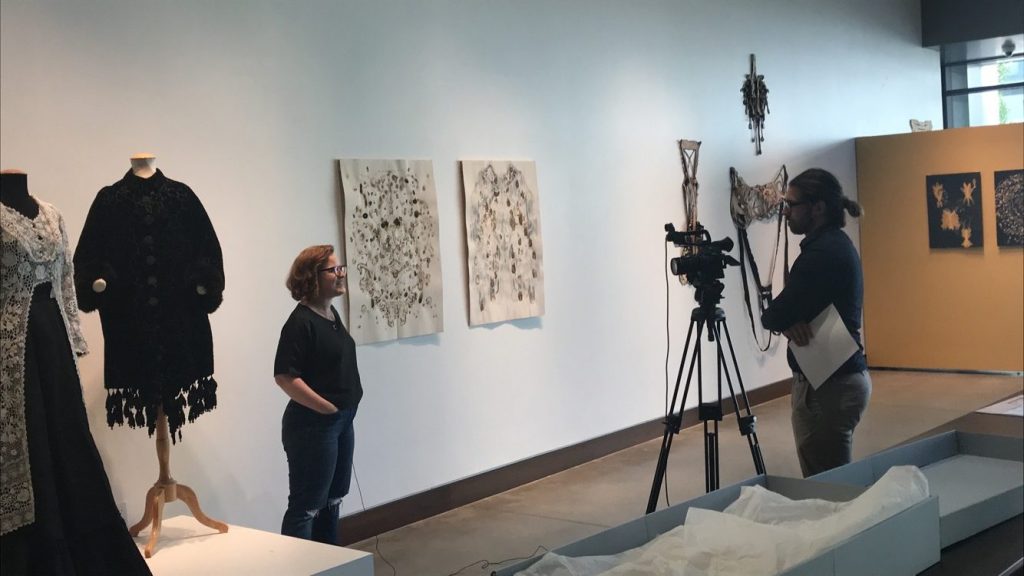Over the past few months, I have been working with Patty Edmonson, the Museum Advisory Council Curator of Costume & Textiles at the Cleveland History Center, the Western Reserve Historical Society’s University Circle location. This has proved to be one of the best internships I have ever had; this is my third with the Western Reserve Historical Society. During my internship, Patty has taught me so much about working as a museum professional, exposing me to the good and to the bad. We set goals for the summer that we met and went beyond. I was able to learn about the different hats a curator must wear and the flexibility and skills needed.
For the first week, Patty and I worked on the Mad for Plaid exhibit, putting the finishing touches on the costumes in the main part of the exhibit. We also wrote, mounted, and placed labels in this part. After this was finished, we began placing objects in the surrounding cases. The most memorable part was finding a little girl’s plaid dress in costume storage for one of the cases. We both felt that it was an important piece, but since the main exhibit space was finished, we decided to give it its own special case on the side.
After this, Patty told me that there were cases in the Western Reserve Historical Society’s Research Library that needed to be filled. We decided to place children’s plaid clothing here, since the majority of garments in Mad for Plaid were made for and worn by adults, to connect the two ends of the museum. I loved going through the children’s garments in costume storage and pulling many for this display. Before we could put the mannequins on display we had to dress them. Now I do not simply mean putting the garments on them, but also choosing the proper mannequins, adding the correct undergarments, stuffing arms and legs with polyester batting, and steaming out the wrinkles. After we pared down our options and dressed the mannequins, we began researching the families of the children who wore them for background information to inform our labels. I discovered a love for genealogy here. I also rediscovered my love for research and telling a story. In the labels I wrote, I was able to tell much more than just why a style was popular during a time period or what it was made of. I learned about who wore it, often by looking at the deeds of gift or researching the donor family. Also, Patty taught me to use Ancestry.com to uncover information about the children in our display. Upon donation, one of the silk dresses had a tag inside claiming that although worn by Winnie, “this dress was made for EAN [Elizabeth Ann Nash].” I looked into the Nash family and discovered that Winnie was Elizabeth’s younger sister! It is moments like this that made me remember my love and yearning for new knowledge.
Of course, not all days were spent adventuring through costume storage to find just the right outfit or digging through ancestry.com’s records. We occupied days with reorganizing the storage areas or doing maintenance on the crumbling bits. We spent time cataloging new requisitions; Patty taught me the best way to write accession numbers on artifacts without ruining them. Even while doing jobs that seemed mundane at first proved priceless to my learning.
One thing I was extremely excited for at the start of my internship was having the opportunity to design my own exhibit and do the research, writing, and choosing of objects essentially on my own. With Patty’s guidance, I chose costume pieces, as well as other artifacts, from the museum’s collection, to help make the Hay-McKinney Mansion, one of the museum’s historic mansions, more inviting to the visitor. My idea aimed to help connect visitors to the people of Cleveland, not just the architecture or Millionaire’s Row residents; I wanted to tell the stories of the less affluent members of the nineteenth century Cleveland society. While previously employed at the Cleveland History Center, I often gave tours of this house. I was always fascinated by the difference in designs between the servants’ quarters and the rest of the house, as well as with the staircase and its story. From my talks with Patty and other of the museum’s staff, as well as my own personal experiences, I learned that visitors like learning the names of people, not just hearing “someone of this stature would have worn this outfit.” Using this tidbit of information, I began looking into some of the more obscure objects and people in the mansion. I wanted to tell their stories. I developed this exhibit with these previous interests and thoughts in mind. I was able to find a very interesting piece of clothing – a maid’s apron from 1901. While reading the records and the provenance, I discovered its owner and learned more about her, thus allowing me to tell her story.
Overall, working with Patty this summer has proved immeasurably beneficial to my future in the museum profession. Without her openness and willingness to each I would not have learned about all the work that really goes into putting together and opening an exhibit. As I said before, I rediscovered many of my passions in the past few months. Patty’s excitement and passion for each project, as well as that of other museum staff, allowed me to see past the downsides and politicking involved in the profession. This entire experience helped remind me why I chose to study museums and history.





